Abstract
Cotton and woolen fabrics and fabrics of synthetic fibers were exposed by direct contact (pipette) and by aerosolization to poliovirus and to vaccinia virus in separate experiments, allowed to dry for 16 hr at 25 C in 35% relative humidity, and randomly tumbled with sterile swatches of the same fabrics for 30 min. By use of a HEp-2 cell assay system, up to 103.5 CCID50 of poliovirus per ml and 104.4 CCID50 of vaccinia virus per ml were recovered from the originally sterile fabrics as early as 1 to 10 min after contact. Maximum transfer of both viruses was achieved with wool blanket material, although high titers of vaccinia virus were recovered from all fabrics tested. Poliovirus placed on the fabrics in an aerosol tended to be transferred to the sterile fabrics at a greater rate than when it was placed on the fabrics by direct contact. The method of exposure had essentially no effect on the rate of transfer of vaccinia virus.
Full text
PDF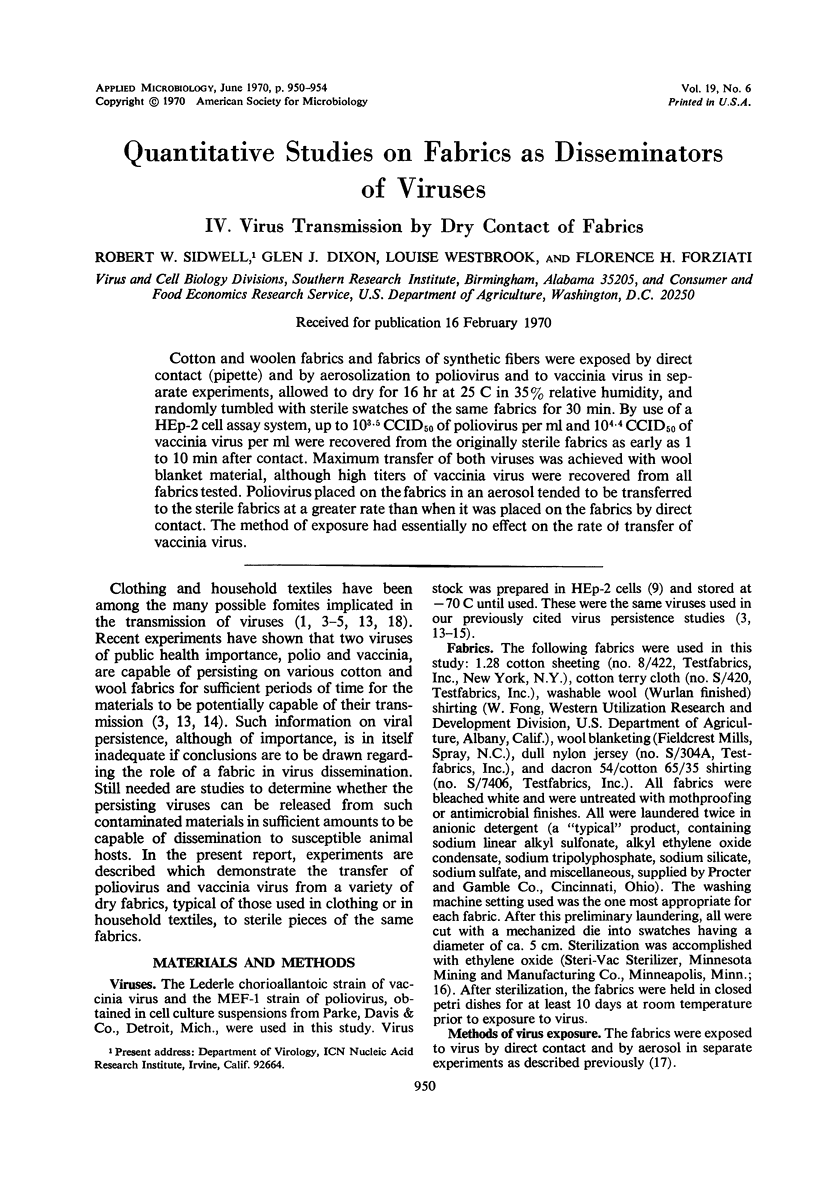
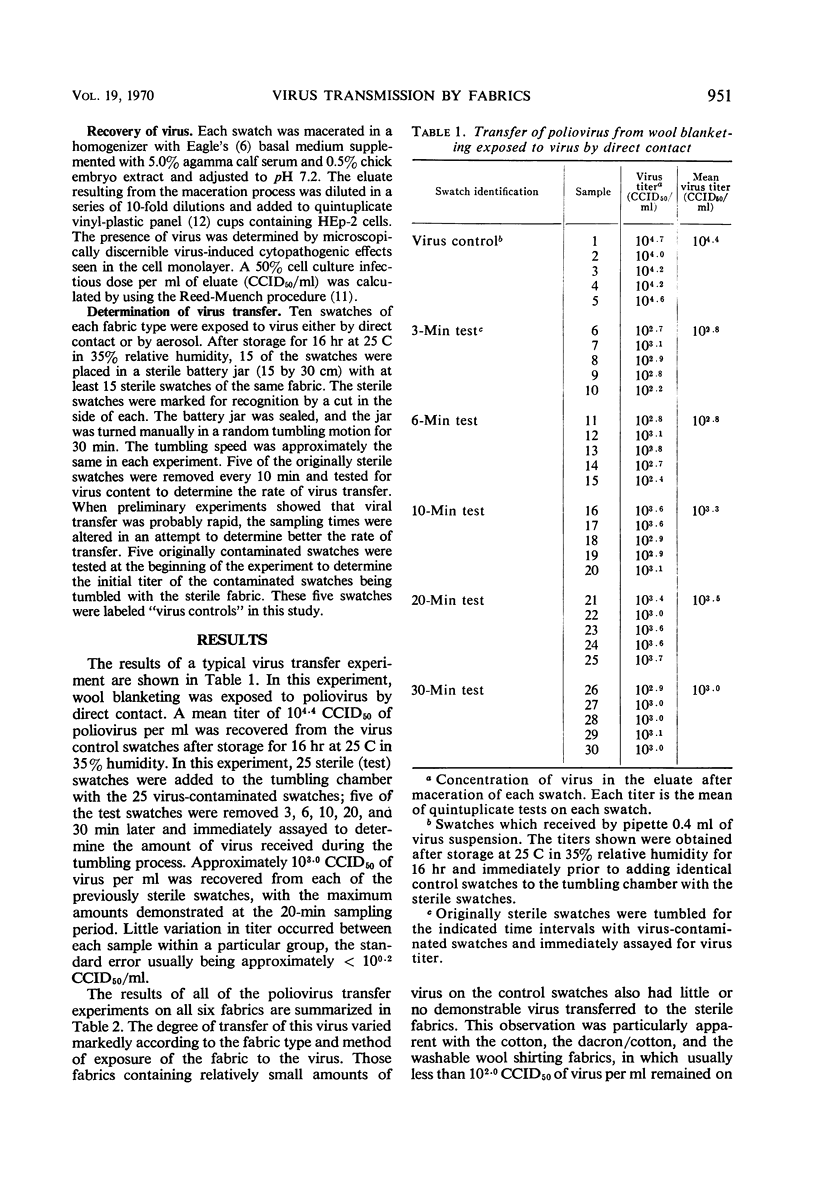
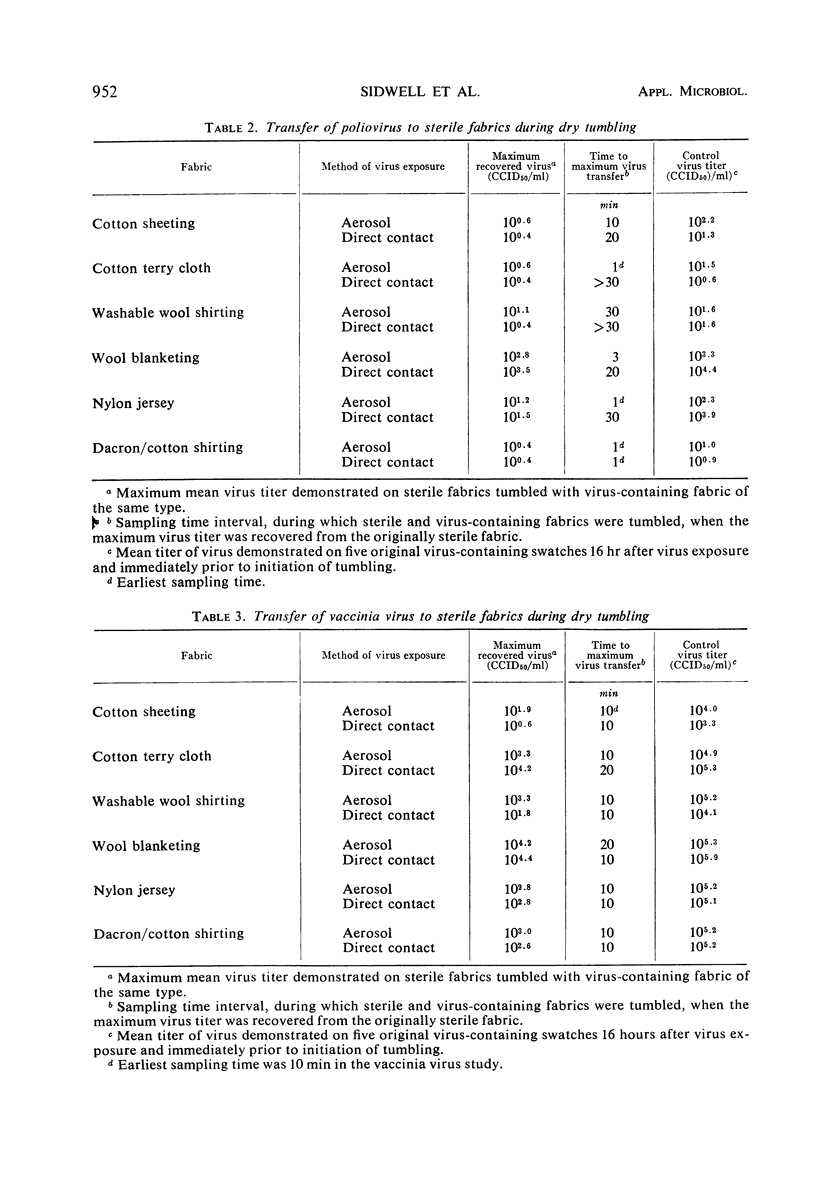
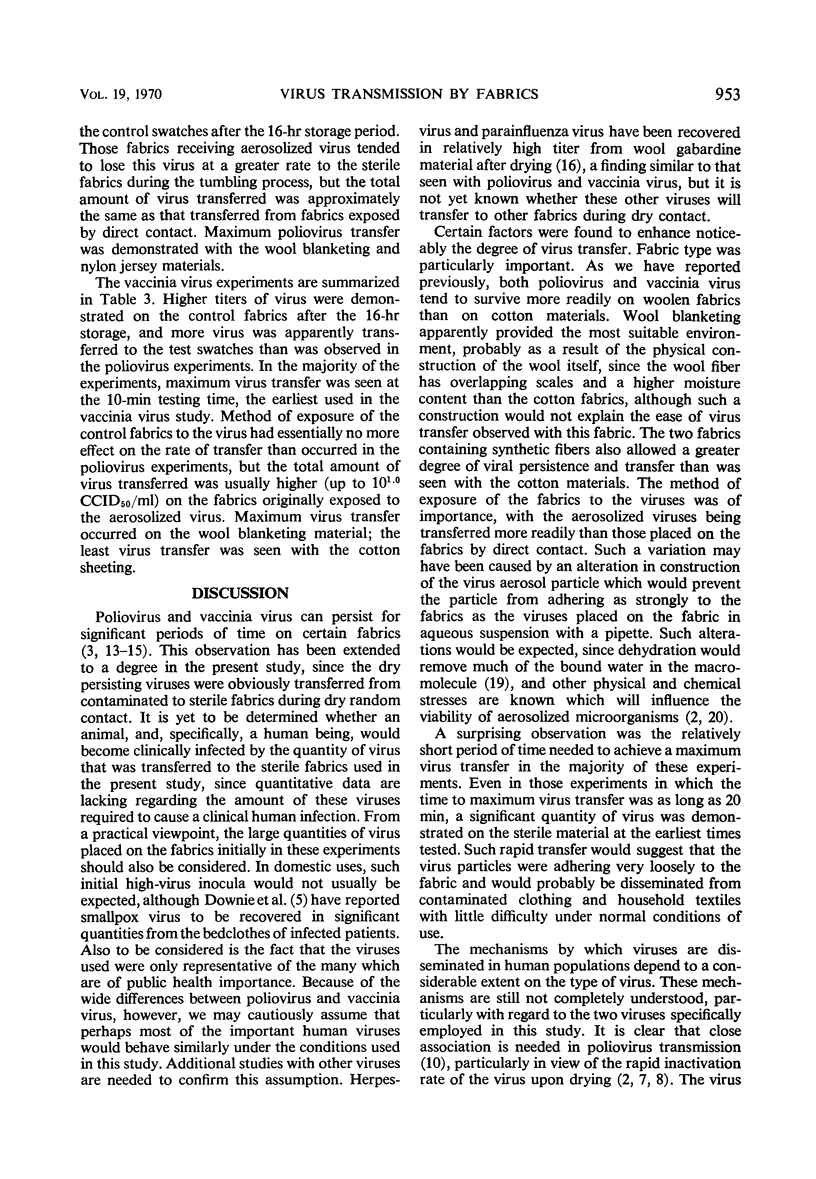
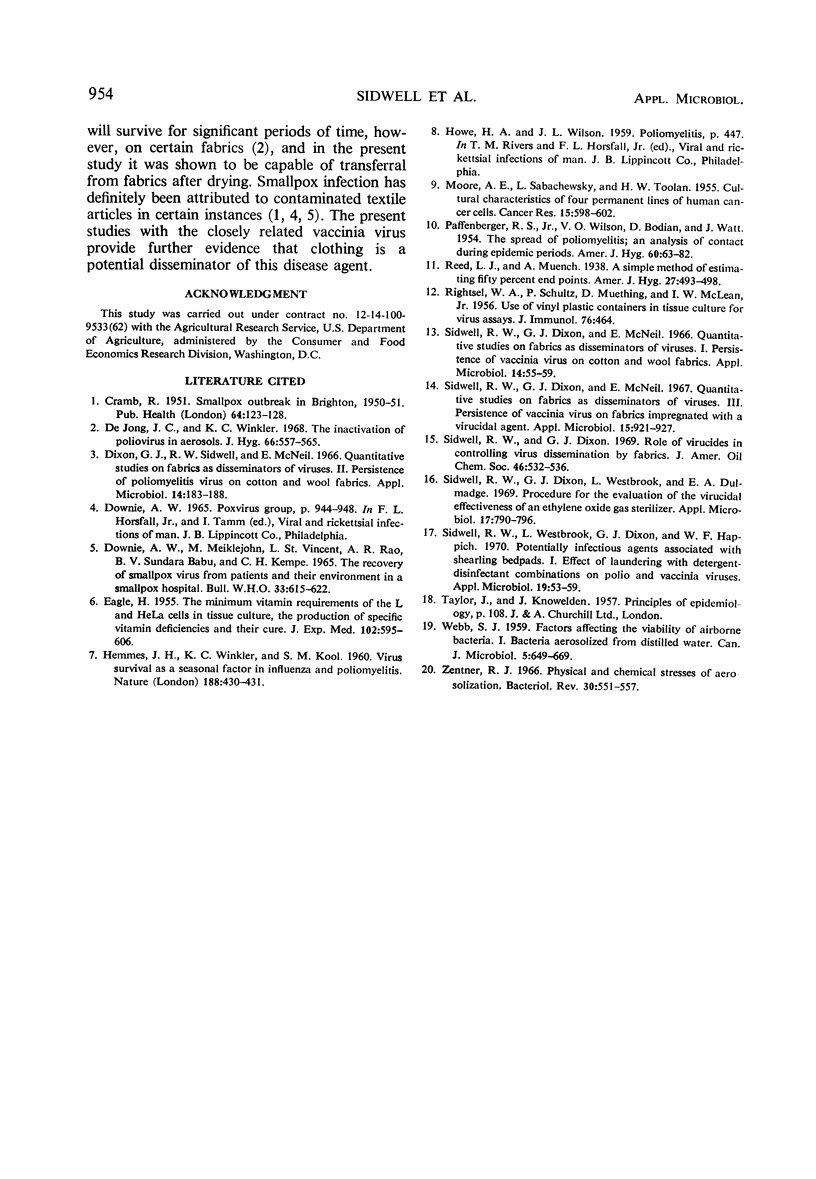
Selected References
These references are in PubMed. This may not be the complete list of references from this article.
- CRAMB R. Smallpox outbreak in Brighton, 1950-51. Public Health. 1951 Apr;64(7):123–128. doi: 10.1016/s0033-3506(50)80114-2. [DOI] [PubMed] [Google Scholar]
- Dixon G. J., Sidwell R. W., McNeil E. Quantitative studies on fabrics as disseminators of viruses. II. Persistence of poliomyelitis virus on cotton and wool fabrics. Appl Microbiol. 1966 Mar;14(2):183–188. doi: 10.1128/am.14.2.183-188.1966. [DOI] [PMC free article] [PubMed] [Google Scholar]
- Downie A. W., Meiklejohn M., St Vincent L., Rao A. R., Sundara Babu B. V., Kempe C. H. The recovery of smallpox virus from patients and their environment in a smallpox hospital. Bull World Health Organ. 1965;33(5):615–622. [PMC free article] [PubMed] [Google Scholar]
- EAGLE H. The minimum vitamin requirements of the L and HeLa cells in tissue culture, the production of specific vitamin deficiencies, and their cure. J Exp Med. 1955 Nov 1;102(5):595–600. doi: 10.1084/jem.102.5.595. [DOI] [PMC free article] [PubMed] [Google Scholar]
- HEMMES J. H., WINKLER K. C., KOOL S. M. Virus survival as a seasonal factor in influenza and polimyelitis. Nature. 1960 Oct 29;188:430–431. doi: 10.1038/188430a0. [DOI] [PubMed] [Google Scholar]
- MOORE A. E., SABACHEWSKY L., TOOLAN H. W. Culture characteristics of four permanent lines of human cancer cells. Cancer Res. 1955 Oct;15(9):598–602. [PubMed] [Google Scholar]
- PAFFENBARGER R. S., Jr, WILSON V. O., BODIAN D., WATT J. The spread of poliomyelitis, an analysis of contact during epidemic periods. Am J Hyg. 1954 Jul;60(1):63–82. doi: 10.1093/oxfordjournals.aje.a119704. [DOI] [PubMed] [Google Scholar]
- RIGHTSEL W. A., SCHULTZ P., MUETHING D., MCLEAN I. W., Jr Use of vinyl plastic containers in tissue cultures for virus assays. J Immunol. 1956 Jun;76(6):464–474. [PubMed] [Google Scholar]
- Sidwell R. W., Dixon G. J., McNeil E. Quantitative studies on fabrics as disseminators of viruses. 3. Persistence of vaccinia virus on fabrics impregnated with a virucidal agent. Appl Microbiol. 1967 Jul;15(4):921–927. doi: 10.1128/am.15.4.921-927.1967. [DOI] [PMC free article] [PubMed] [Google Scholar]
- Sidwell R. W., Dixon G. J., McNeil E. Quantitative studies on fabrics as disseminators of viruses. I. Persistence of vaccinia virus on cotton and wool fabrics. Appl Microbiol. 1966 Jan;14(1):55–59. doi: 10.1128/am.14.1.55-59.1966. [DOI] [PMC free article] [PubMed] [Google Scholar]
- Sidwell R. W., Dixon G. J. Role of virucides in controlling virus dissemination by fabrics. J Am Oil Chem Soc. 1969 Oct;46(10):532–536. doi: 10.1007/BF02633177. [DOI] [PubMed] [Google Scholar]
- Sidwell R. W., Dixon G. J., Westbrook L., Dulmadge E. A. Procedure for the evaluation of the virucidal effectiveness of an ethylene oxide gas sterilizer. Appl Microbiol. 1969 Jun;17(6):790–796. doi: 10.1128/am.17.6.790-796.1969. [DOI] [PMC free article] [PubMed] [Google Scholar]
- Sidwell R. W., Westbrook L., Dixon G. J., Happich W. F. Potentially infectious agents associated with shearling bedpads. I. Effect of laundering with detergent-disinfectant combinations on polio and vaccinia viruses. Appl Microbiol. 1970 Jan;19(1):53–59. doi: 10.1128/am.19.1.53-59.1970. [DOI] [PMC free article] [PubMed] [Google Scholar]
- Zentner R. J. Physical and chemical stresses of aerosolization. Bacteriol Rev. 1966 Sep;30(3):551–558. doi: 10.1128/br.30.3.551-558.1966. [DOI] [PMC free article] [PubMed] [Google Scholar]
- de Jong J. C., Winkler K. C. The inactivation of poliovirus in aerosols. J Hyg (Lond) 1968 Dec;66(4):557–565. doi: 10.1017/s0022172400028308. [DOI] [PMC free article] [PubMed] [Google Scholar]


